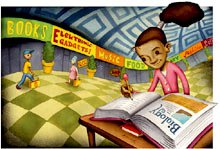Mall School: Alternative Academics Make the Grade
Reading, writing, and retailing.
Your content has been saved!
Go to My Saved Content.
Shamela Armstead jumps off a city bus and heads briskly into Seattle's Northgate Mall. The energetic sixteen-year-old skirts the adolescent allure of the Sunglass Hut and the California Pizza Kitchen before dashing upstairs. It's only eight in the morning, but Armstead isn't skipping school. Just the opposite -- she's attending it.
Armstead is one of seventy-five high schoolers enrolled at the Mall Academy, an offbeat place that gives underachieving students a way to earn their diploma. "We figured that a lot of kids are going to be hanging out at the mall anyway, so why not put a school there?" says Karen Hansen, a humanities teacher. "At first, people think it's just for kids who like to shop. It's not. It's for kids who want to graduate."
The Mall Academy -- technically, the Northgate Mall Education Resource Center -- is part of a chain of high schools established by the Simon Youth Foundation (SYF), an arm of one of the nation's largest mall developers. With malls in thirty-nine states plus Puerto Rico, the Simon Property Group hopes to rapidly spread its schooling franchise. The foundation has enrolled 2,100 students in twenty-one schools in eleven states.
Like all the SYF-affiliated schools, Northgate serves academically struggling students. Northgate attempts to break the downward spiral with a combination of smaller class sizes (typically eighteen kids per class) and increased one-on-one teaching, while emphasizing traditional bedrock subjects such as math, science, social studies, and English.
With the smaller size comes the opportunity for more varied learning. Class trips are frequent; last year's excursions included visits to the Tacoma Art Museum and the Experience Music Project, an interactive museum in Seattle.
The bustle of shoppers rarely intrudes on the quiet academic setting, one floor above the mall's main passageway. The mall is in many ways a partner in the educational experience. Classes in marketing, for instance, are enhanced with trips downstairs to one of Northgate's 125 stores to check on product placement and display. For lunch, kids are issued tickets good for a meal in the food court. Some students also have after-school jobs at mall stores.
The result, while nontraditional, is effective. More than 90 percent of those who make it to senior year earn their diplomas.
Armstead, too, has seen the change. At her previous school, her grade point average was 2.8. At Northgate, it's 4.0, and she has a new love for reading. "My friends used to think it was weird that I went to school at the mall," says Armstead. "But now I think they're just jealous."